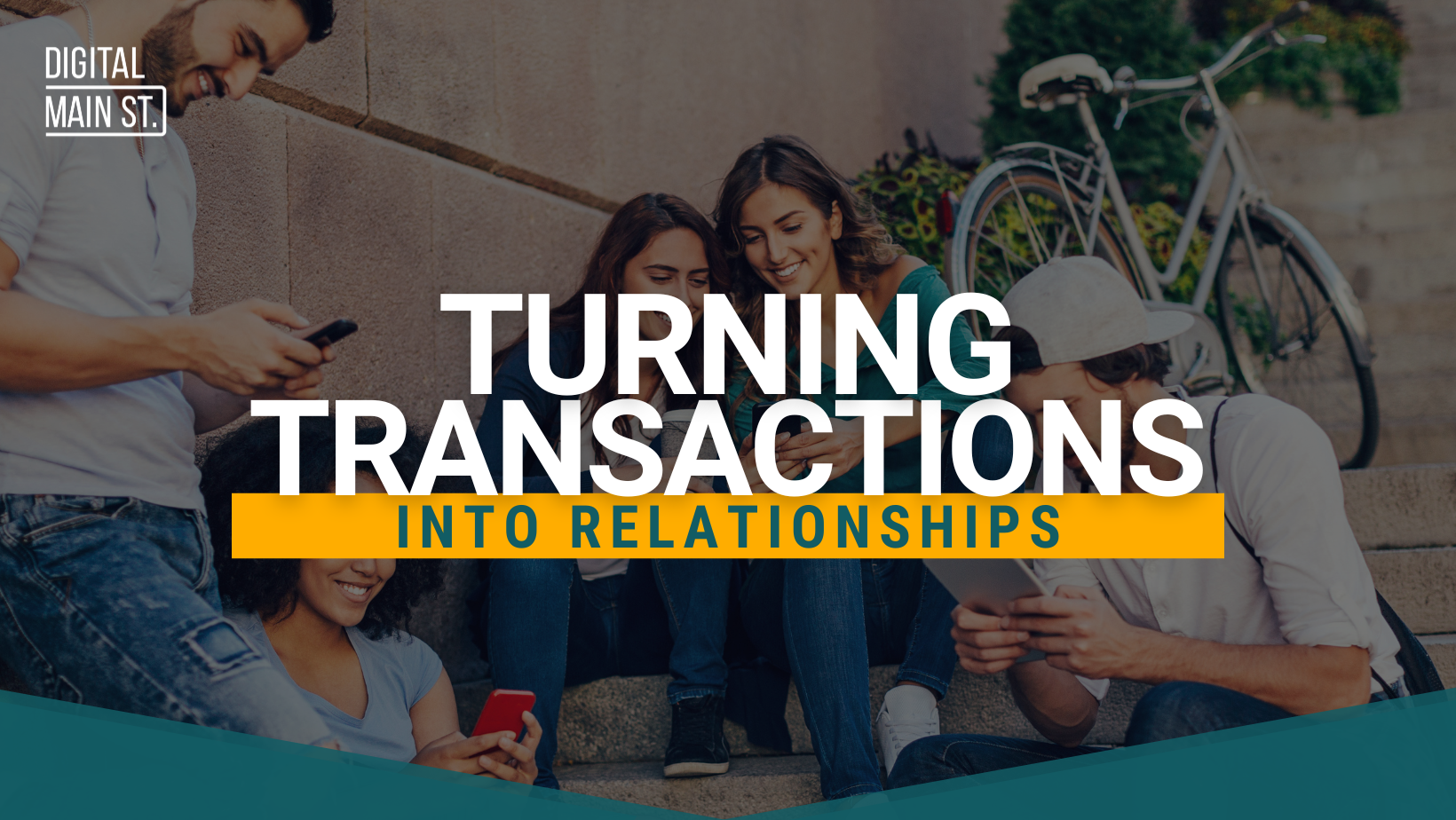
Turning Transactions into Relationships
Building strong customer relationships is the foundation of any successful business. A relationship with a customer can take many forms, and often, consumer and business relationships tend to be defined as transactional. In this blog, we want to highlight the importance of turning transactional relationships into longstanding communal relationships and how small businesses can leverage their size to facilitate this transition with their customers.

This Small Business Month, I want to highlight the importance of how shifting from transactional to community-focused relationships can contribute to the long-term success and survival of your business. A successful community helps with customer engagement, brand advocacy and loyalty, as well as recall and retention.
From Clicks to Connections
Humans are social creatures, so it’s no surprise that we have an unconscious drive to search for belonging amongst communities. As our technology evolves, so has the idea of what a community is. Communities extend beyond the immediate and proximal comradery that you’d find in real-life settings. Community now encompasses the intangible and expansive online space; however, the role of a community has not changed, it just looks a little different because of shifts in technology and consumer behaviour. As a result, while the essence of community remains unchanged, e-commerce and social media have disrupted the traditional consumer model, reshaping how communities interact and engage. Convenience, accessibility, and visibility are all factors a customer will consider before making a purchase but resonating with your brand could make or break someone’s decision to support your business. That’s where community building becomes important.
Consider this – A customer named Sophie is planning a wedding and she wants every table to have a unique arrangement of dried flowers. As Sophie is conducting research online, she discovers two competing floral shops in her area: Business A and Business B. Both businesses have beautiful and easy to navigate websites, but Business A is utilizing social media to showcase their work and interact with their customers online. Sophie spends some time going through Business A’s social media posts and reading comments. Through image posts, she can visualize how the arrangements will look at her wedding. Through the comments, she can feel a sense of connection to the business and their customers and reads amazing feedback from other brides. By now, she has completely forgotten about Business B. She schedules a consultation and decides to work with Business A. Sophie’s experience was so great that after the wedding she left a 5-star review on Google, now follows and comments on posts from Business A on Instagram and recommends them to her friends who are looking for a floral shop. By making themselves accessible across platforms, and engaging with their customers, Business A used their platforms to showcase what they have to offer. This sets them apart from their competitors, helped them to connect meaningfully with shoppers like Sophie, and gained a loyal customer.
At the end of the day, what matters is the impression you’re making online and the meaning behind the interactions you have. You will find most success in nurturing the growth of your community by being authentic. This means ditching any pre-conceived notions of how your business should interact with people online and remembering to be human first. Share some real stories, respond to people, and always be open to feedback.

Cultivating Longstanding Relationships
You may have read our previous blog titled “Creating Lasting Bonds” where we discussed what brand loyalty is, how it impacts small businesses, and how a community can be used to build brand loyalty amongst your customers. Here, I will be expanding on brand loyalty and discussing what will turn a customer into a loyal brand advocate.
Have you ever heard of the 80-20 rule? This rule, also known as the Pereto Distribution principle, asserts that 80% of outputs result from 20% of inputs (Investopedia, 2023). In the context of running a business, it implies that 80% of your total sales (outputs) will come from 20% from your customers (inputs). That 20% represents your community of loyal customers who will return to purchase from your business because you have created a positive perception of your business with lasting impact.
How do you actually create a sense of brand loyalty? It’s less complicated than it sounds, and it ties directly to your ability to effectively communicate and connect with your customers. Every interaction with a customer or potential customer becomes an opportunity to acknowledge and fulfill an emotional need and it doesn’t take much to make a customer feel seen – Simply responding to a comment or direct message is enough to show someone that you genuinely care.
As previously mentioned in this article; being human and representing your brand authentically will be the keys to success when trying to entice a buyer to become a brand loyalist. Your ability to create and maintain an online community will directly impact the growth and trajectory of retaining loyal customers. A customer’s loyalty to your brand is what will ultimately determine the strength of your community, and the outcome of repeat purchases.

Complimenting Your Online Presence
If everything is by design, that means your online presence should be carefully crafted and designed to work. Creating a cohesive online presence requires more than just the intention, rather it requires careful consideration and curation. Your customers' experience of your brand online should feel consistent.
In addition to the work I do to support small businesses at Digital Main Street through our programs, I am also a small business owner myself, owning a local skateboard shop in my area. Every few weeks we receive deliveries of new product that we need to quickly receive into our inventory, photograph, and make available to our customers. We don’t just upload our inventory and cross our fingers; we make it an all-encompassing online experience for our customers every time we release new products. How do we do this? First, we start on the website, making sure that we update our featured product section after uploading our new product. Second, once the backend of the website is loaded, we decide on a release date and work on social posts and a newsletter to share. Our priority is to always inform our email subscribers before posting on our socials and this is because we make a promise of sharing news and updates with them before we do so in a public space. Finally, we create cohesion through visuals and tone and ensure that all our activity online directs returning and potential new customers to our website.
By nurturing a cohesive and engaging online experience, we have built strong relationships with our community of customers. This approach not only supports our business goals but also brings people together, creating a sense of belonging and loyalty. This community-centric strategy enhances customer satisfaction and drives sustainable growth, demonstrating that our commitment to cohesion and communication is integral to our success.
Your online presence isn’t just your website, it's your social channels, review platforms, your mailing list, and everything in between. Your goal should be to ensure that any action taken on any platform is complimentary to your entire online presence. Nothing should be posted or responded to without consideration of consistency, cohesion, and ensuring alignment with your brand and goals.

How to Effectively Use a Social Media Strategy to Build Your Community
Apart from the soft skills required to communicate effectively with your customers and draw them towards your brand, it is important to know what practical steps you can take.
Here, I have outlined key steps you can take to effectively use a social media strategy to build your community:
- Define Your Objectives:
- This is where you would set the objectives you are setting out to achieve by implementing a social strategy.
- Example: Community Engagement: Build a loyal audience of customers who resonate and interact with your brand.
- This is where you would set the objectives you are setting out to achieve by implementing a social strategy.
- Choosing Metrics that Align with Your Objectives:
- How will you measure the success of your social strategy? This is where you will determine the metrics you will be informed by.
- Example: Track post engagement metrics such as views, comments, likes, and shares to determine the effectiveness of your content in increasing engagement.
- How will you measure the success of your social strategy? This is where you will determine the metrics you will be informed by.
- Create Value-Driven Content:
- The goal here is to create content that connects and supports the facilitation of building your online community. The value here being to satisfy your customers’ emotional need for connection.
- Example: Create weekly polls about things you’re curious about. It doesn’t always need to be related to selling products or services.
- The goal here is to create content that connects and supports the facilitation of building your online community. The value here being to satisfy your customers’ emotional need for connection.
- Direct Engagement:
- Engaging your customers is an essential part of a social media strategy. By engaging with your customers, you will be working towards building stronger relationships and driving a sense of community.
- Example: Following active customers back, sharing/re-sharing user generated content, responding to comments, asking for feedback, etc.
- Engaging your customers is an essential part of a social media strategy. By engaging with your customers, you will be working towards building stronger relationships and driving a sense of community.
- Review, Learn, and Adapt:
- It’s important to approach any business strategy from the basis that success is a long-term commitment. This means you will need to review your analytics, assess your approach, and remain flexible to changes.
- Example: Set a timeline to review your analytics and assess what went well, and what could be improved for your next post.
- It’s important to approach any business strategy from the basis that success is a long-term commitment. This means you will need to review your analytics, assess your approach, and remain flexible to changes.

Wrap Up
By investing in communal relationships, you also invest in the future of your business. It’s important to note that there are many other channels to reach and engage with customers that businesses should also consider, we have barely scratched the surface in this article. In addition to your website and social media accounts, building a mailing list, hosting localized in-person events, and partnering with other local brands are but a few ways you can continue to expand your reach and build your community.
If you would like to take a deeper dive into understanding, engaging, and growing your online community, please check out our blog “Cultivating Connections.” You can also access our exclusive Digital Main Street Resource Hub for more information on e-commerce, digital marketing, cybersecurity, and artificial intelligence.
To learn more about essential digital strategies for attracting more customers and driving growth for your small business, check out our virtual webinar “Driving Digital Success: Strategies for Small Businesses to Succeed Online.”
